The Salis Flying Museum (Musée Volant Salis) has an amazing collection of around 50* historic aircraft at its hilltop airfield, 35 kms south of Paris.
It’s the drip trays you notice. Drip trays are a rare sight in most aviation museums because, before they go on static display, aircraft are drained of any fluids that are dangerous or may cause damage**. At the Salis Museum, practically every aircraft has a drip tray under every engine – that’s because these aircraft fly!
In that respect the Salis Museum of Flying is rather like our Shuttleworth Collection in the UK, only with a few more aircraft.
The Salis Flying Museum Story
It starts with Jean-Baptiste Salis, who was inspired as a 12-year-old boy by Louis Blériot’s flight across the Channel in 1909, to carve out a career in aviation. Three years later, with some cash from his grandmother, he bought three plane wrecks from the Clermont-Ferrand flying club, took them back to the family farm and managed to rebuild one of them – a Hanriot Dragonfly, that crashed on its first flight.
Then WWI intervened and he became a military pilot. Wounded at the Battle of Verdun, he stepped down from the frontline and became an instructor, test pilot and delivery pilot, delivering aircraft to the front. After the Great War, during the twenties, he was a display pilot in an aerobatic team, and in 1933 he founded a pilots association, Les Casques de Cuir (Leather Helmets), to promote the thrill and skill of aviation to the public, especially youngsters.
Four years later he started collecting and restoring old aeroplanes***, and then bought a 40 acre farm on a hill between Cerny and the commune of La Ferté-Alais, which he turned into an air mechanics school with the support of the Air Ministry.
Everything was interrupted by the Second World War, but immediately after the war La Ferté-Alais Aerodrome was officially inaugurated and granted a restricted license as a private airfield. Jean-Baptiste got back to work restoring vintage aircraft… from scratch. All his machines had been destroyed under the German occupation.
In 1955 he started work on restoring a Blériot aircraft, which he then flew across the Channel in 1959, recreating Bleriot’s flight on its fiftieth anniversary.
Then it starts to get a little complicated.

The unofficial aero “Club of La Ferté-Alais” wanted to curate the history of French aviation, and so formed the “Escadrille du Souvenir” (Remembrance Squadron) in 1965, and five years later it starts organising an “aero-folklore festival”, which becomes the famous annual Ferté-Alais Air Show.
Jean-Baptiste Salis died in Dec 1967.
A year later the Club decided it want to create a museum. In 1972, a new ‘friendly society’, the “Amicale aeronautique de Cerny-La Ferté-Alais” was formed. It then became “l’Amicale Jean-Baptiste Salis” (AJBS) and the flying museum collection began to take shape, starting with Jean-Baptiste’s Blériot XI & Caudron G.3, donated by his son, Jean Salis.
Since then the collection has been expanded with additional aircraft from various collectors and organisations. So now there are nearly 70 aircraft owned and operated by : Forteresse Toujours Volante (B-17); l’Amicale Jean-Baptiste Salis; Memorial Flight; and Les Casques de Cuir.
Early on they became involved, quite naturally, with the movie industry. They first worked on a six-part French-German-Canadian TV series in 1974 about early aviators called ‘Les Faucheurs de Marguerites’ (The Reapers of Daises), about pioneers like Clément Ader, Louis Blériot, Gabriel Voisin, the Wright brothers, Count Zeppelin, and Otto Lilienthal.
Now, the Salis Company**** has worked on over 200 films, notably The Longest Day (1962), Indiana Jones and the Last Crusade (1989), Das Boot (1981), and Empire of the Sun (1987).
Salis Flying Museum – What’s there now?
The museum consists of five roughly chronological themed hangars…
Hangar – The Pioneers and the Great War
This hangar has a dozen rather amazing classics of early aviation, starting with the ungainly Caudron G.111.
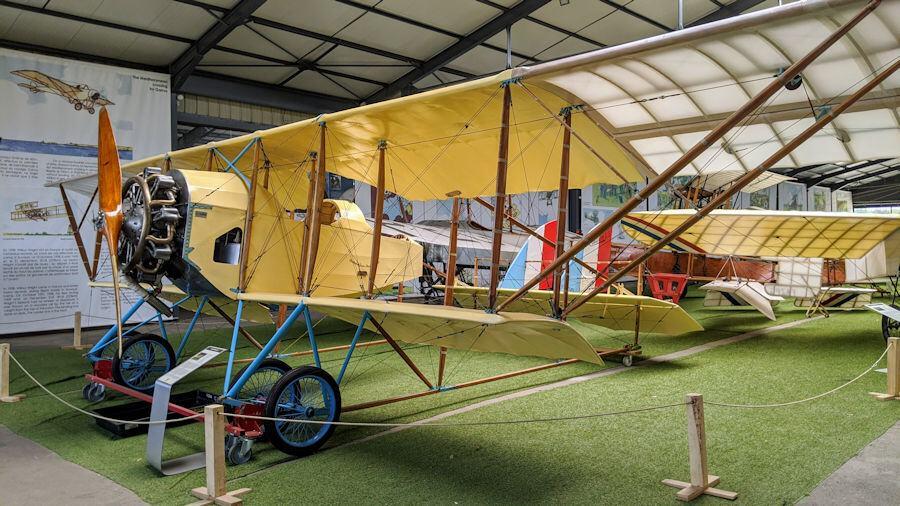
It looked familiar when I saw it, and I now realise that’s because there is one in the RAF Museum in London. Not surprising really. Fifteen hundred of these amazingly successful box framed machines were produced during WW1 by the French Caudron brothers. What I didn’t notice was the control surfaces. This one has ailerons. The original G3s used ‘wing warping’ just like the Wright bros and like the one in Hendon, but later they switched to ailerons… and this aircraft, built in 1991 by l’Amicale Jean-Baptiste Salis from original plans, goes for the aileron option!
Next up, an important machine for Salis! The Bleriot XI.
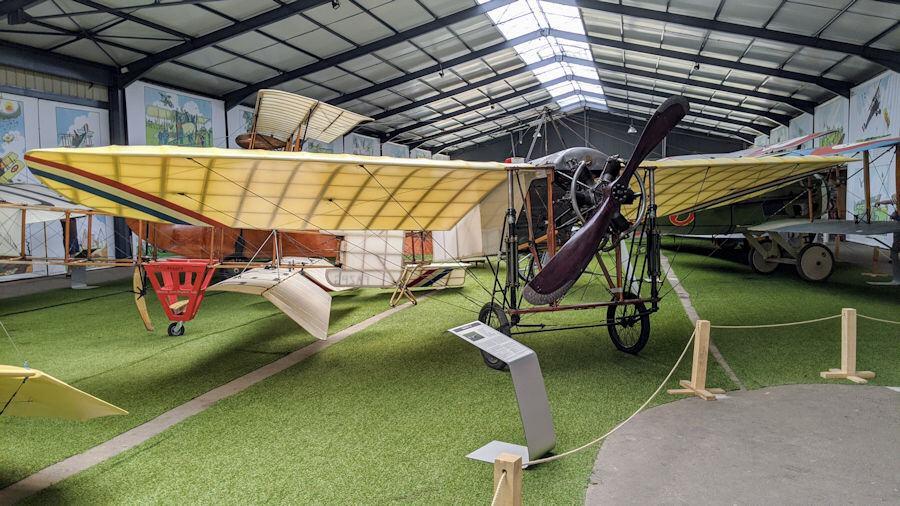
Not a reproduction. This is the real deal! It’s the last Bleriot XI to leave the factory in, can you believe it, 1934?! It was built by Bleriot’s workers to commemorate his famous crossing of the Channel – the one that so inspired the future life of Jean-Baptiste. This was the aircraft that Jean-Baptiste bought, restored, and flew across the Channel in 1955, then again on the 50th anniversary (1959) of Bleriot’s crossing. Next up, his son, Jean flew it across the Channel in 1976. Then, in 1989, Jean-Claude Caillou flew it across for the 80th Anniversary. And, in 2009, Edmond Salis (Grandson) flew it across for the 100th Anniversary. Honestly, this machine has been across the channel almost as regularly as a DFDS ferry!
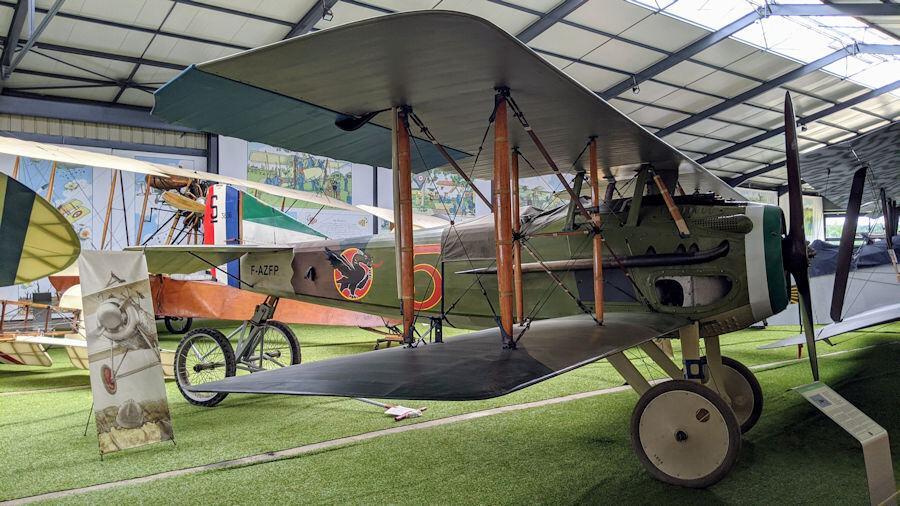
The 235 kph SPAD XIII, also not a reproduction but a rebuild, was a formidable French aircraft that outclassed most British & German machines at the time. It’s 220hp Hispano-Suiza engine allowed it to out-climb and out-run its enemies. I don’t think I’ve ever considered what SPAD might stand for, but it turns out Sociéte pour les Avions Déperdussin went bankrupt in 1914 and when Louis Bleriot bought the company, he decided to keep the brand reputation alive by adjusting it to Sociéte pour Avions et ses Dérivés.
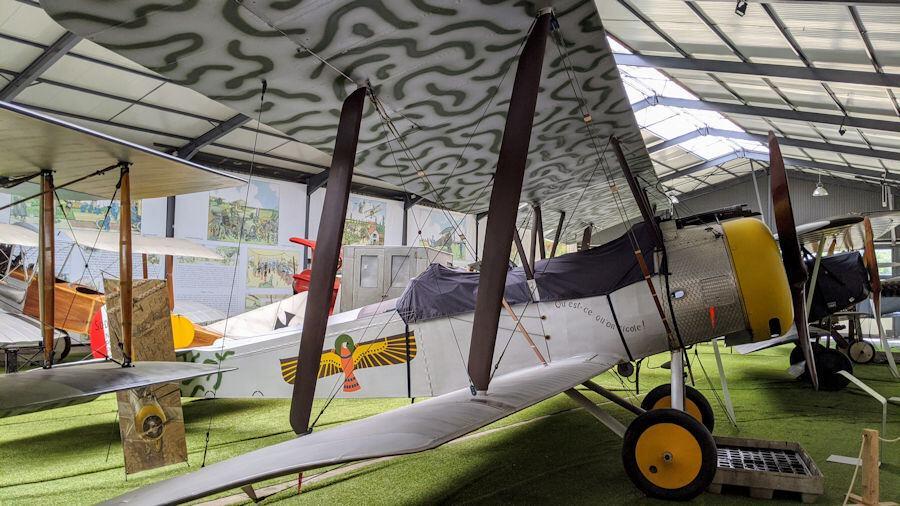
The 2-man Sopwith 1½ Strutter 1B2, with its Clerget 130hp engine was nothing like as fast as the SPAD and, by the time it was delivered to the front in 1917 as a bomber & reconnaissance aircraft it was already obsolete. They were withdrawn from frontline operations the following year. This aircraft, No. 2897, was one of those 1917 deliveries. Memorial Flight started rebuilding it from the few parts remaining, in 2001.
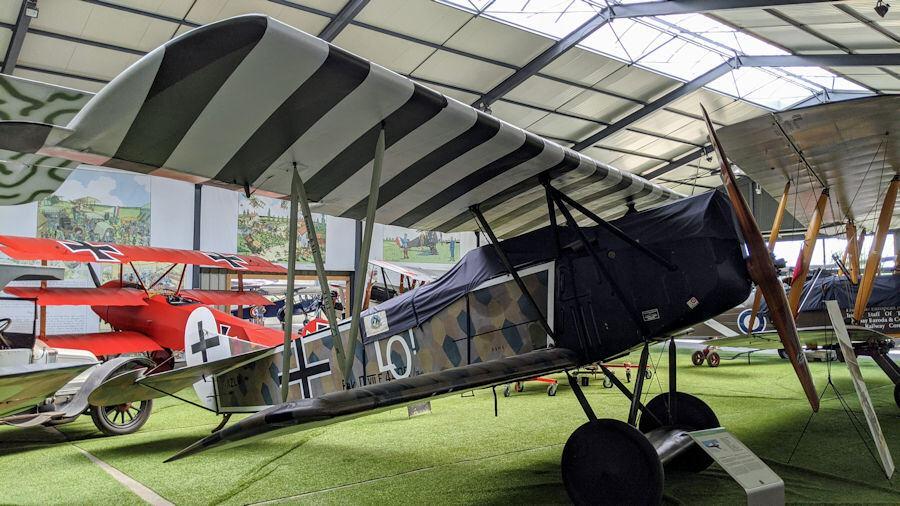
The Fokker DVII was Germany’s answer to the SPADS and SE5s that dominated the sky over the trenches, but its arrival in April 2018 was too late to have any real effect. This one is a reproduction based on original drawings and documents, but what makes it special is the authentic 185hp BMW IIIa engine, which Jean Salis found being used as a generator in a factory.
Other classic aircraft in this hangar are…
The pre-war (1912) and rather slender-looking Royal Aircraft Factory BE2, which was underpowered (70hp) and suffered badly at the hands of German fighters at the beginning of WW1. This one is a Memorial Flight reproduction.
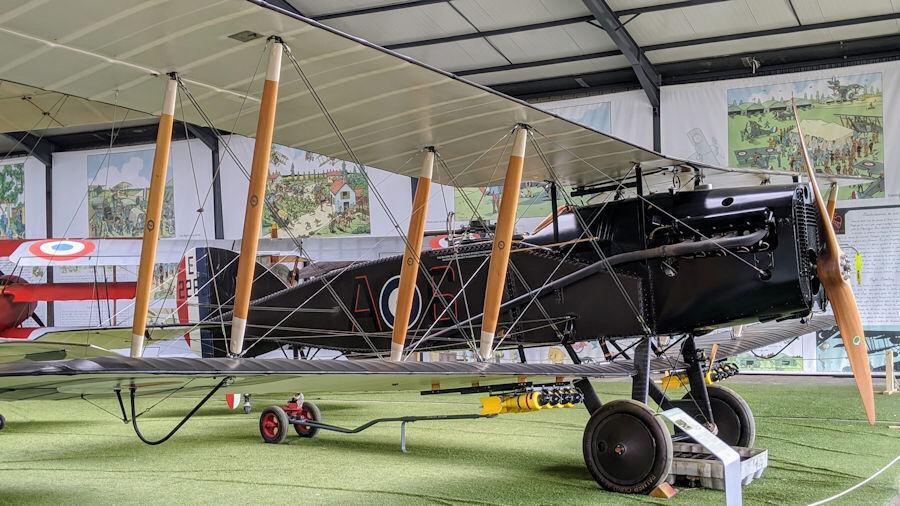
The 2-man Bristol Fighter F2B operated by Les Casques de Cuir, was originally designed as an armed reconnaissance plane in 1916. But then it was fitted with the new 275hp water-cooled V12 Rolls Royce Falcon III engine, which turned it into a robust 200 kph fighter.
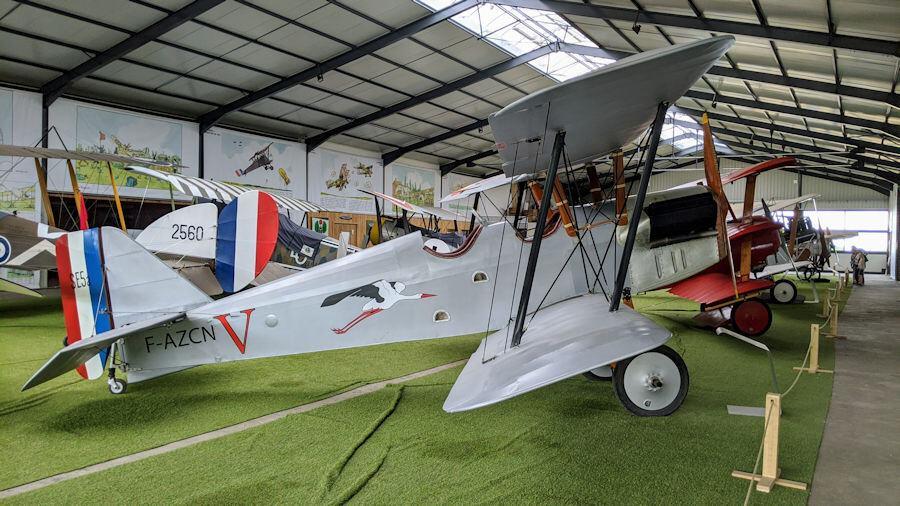
The SE5 replica is interesting. It’s a movie prop. It was designed and built by Salis Aviation in 1982 as a two seater for the movie ‘Ace of Aces’, so that they could fly aerobatics with the pilot in the back and the lead actor, Jean-Paul Belmondo, in the front. It has modern equipment and a Lycoming engine. They also built a second single seater version for exterior shots. Both aircraft, which are not really like SE5s, are re-painted as different movies require.
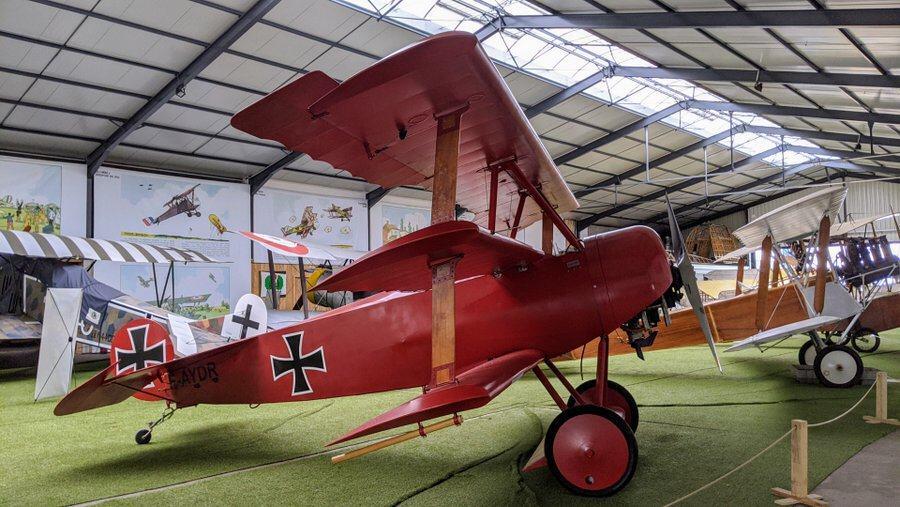
There’s a red-painted Fokker DR1 Triplane replica made in 2011 – very handy for Red Baron movies!
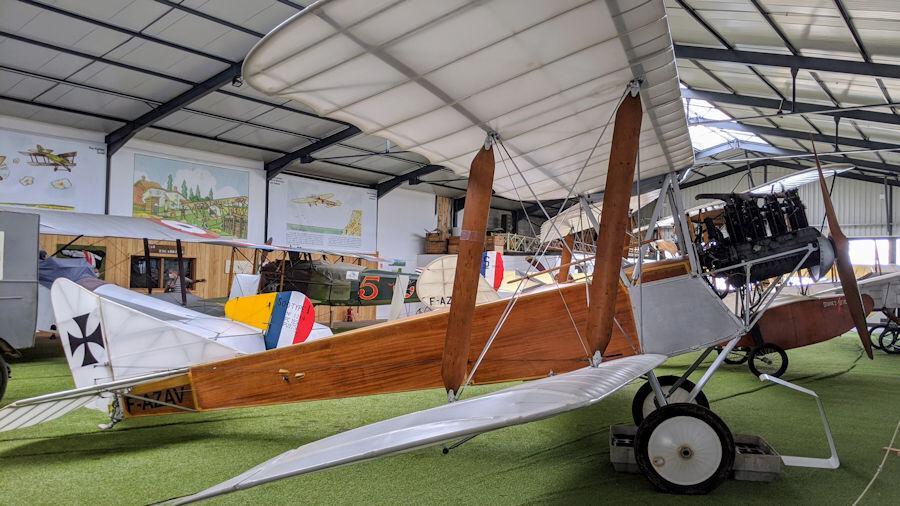
The Albatross C2 is another film prop, built for the ‘Les Faucheurs de Marguerites’ TV series. It’s actually a Tiger Moth conversion with a Gypsy Moth engine.

The Donnet-Lévêque Type C flying boat is a replica built (over 20 years) by Les Retro Planes d’Argenteuil. It first flew in 2017 with Edmond Salis at the controls. The flying boat was the third design by French aircraft designer Francois Denhout, but unlike its predecessors it doesn’t bear his name because, running short of funds he turned to financier Jerome Donnet and engine manufacturer Henri Lévêque who formed the new company.
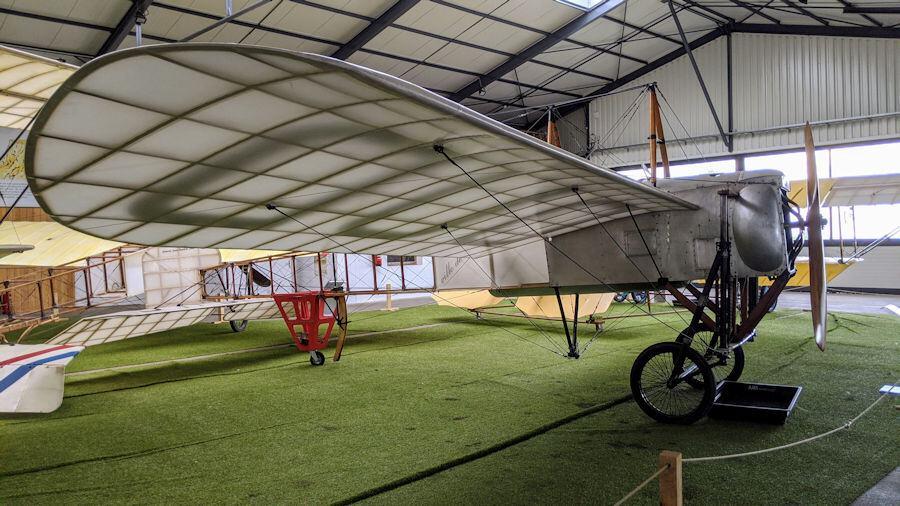
The other Bleriot XI. This one is a replica of the Bleriot XI-2 “Pégoud”, a two-seater version of the X1 named after Bleriot test pilot Adolphe Célestin Pégoud. Pégoud was the first man to jump from an aeroplane (a sacrificial XI) wearing a parachute. As he floated down he watched his, now unmanned, aircraft describe a series of loops, which gave him the idea he could loop-the-loop. In 1913 managed to do it, and was hailed as the first, but he wasn’t. A Russian pilot had performed a loop two weeks earlier!
The Pioneers and the Great War hangar is the cornerstone of the Salis Flying Museum, covering its early focus and aspiration. The other hangars are less busy but still fascinating.
Hangar – The Beginnings of Air Travel
The Beechcraft 18 was designed between the two world wars and then mass produced as a transport and trainer aircraft during WW2… and beyond. Right up to 1967! This particular one was built in 1957 and used as a civil aircraft in Kentucky & Florida till the seventies when it became a skydiving transporter for a parachute school. It was acquired and overhauled by L’Amicale J.B. Salis in the late 80s, and painted up in its US Army colours in 2000.
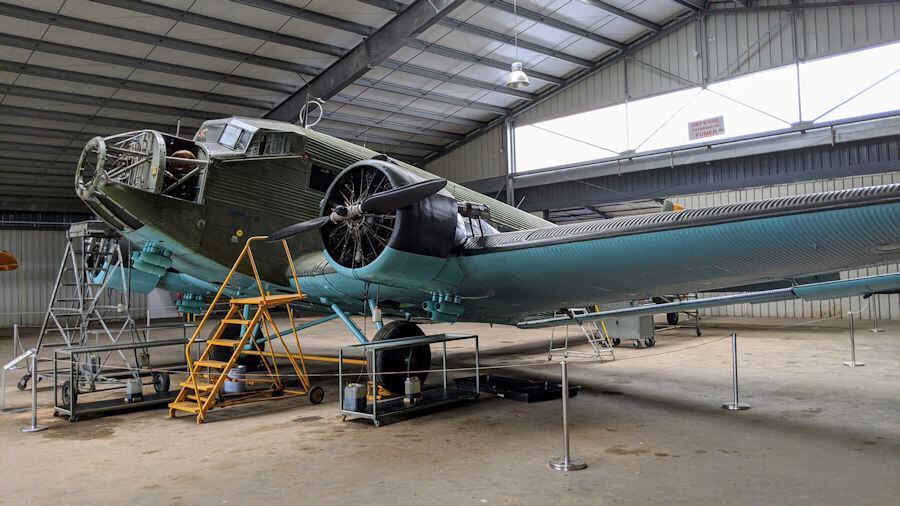
It’s always good to see a Junkers 52 up close (feature image). What an amazing aircraft! The ever-reliable mainstay of Luftwaffe logistics. This one, restored to airworthiness by Amicale J.B. Salis in 2003, is not actually a Junkers, but a CASA 352; the post-war licensed version built by the Spanish Construcciones Aeronáuticas SA (CASA) company – rather like the Bf109 and Heinkel III CASA copies that you can see in the movie ‘Battle of Britain’.
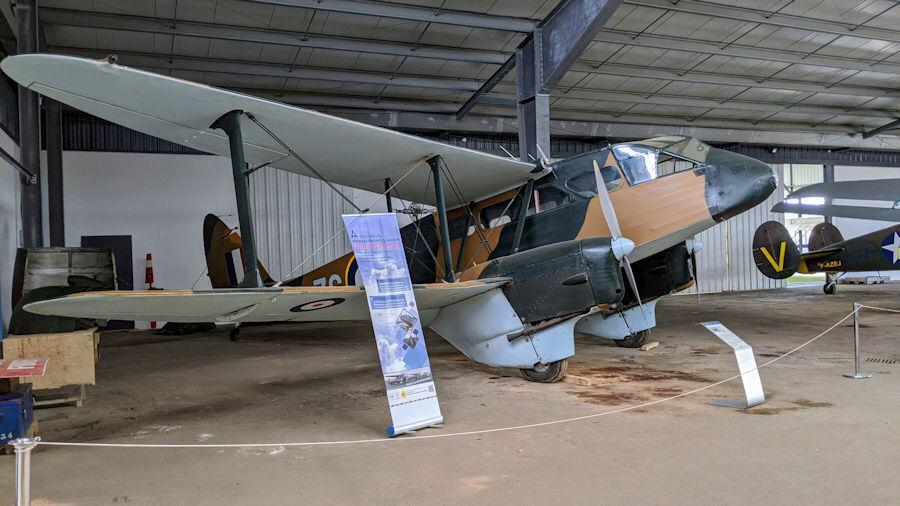
Everybody loves the De Havilland DH 89 Dragon Rapide or the military variant, the Dominie. It’s an elegant aeroplane that evokes the era of the 1930s.***** This one began its life in 1940 with the British Army. In 1981 Jean Salis bought it, overhauled it and entered the Paris Air Show Transatlantic Race from Paris to New York and back.
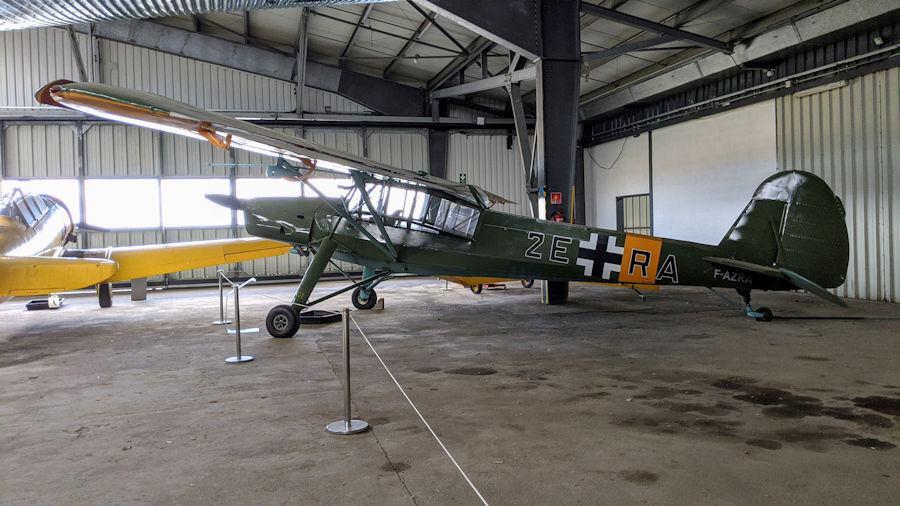
I always think that if a child were to blow out their birthday candles nearby, the Storch would lift up momentarily!I was especially pleased to see the magnificent Fieseler Storch 156. Designed in 1935 as a Short Take Off & Landing (STOL) aircraft, to be a reconnaissance and transport aircraft operating ‘in the field’ close to the front line. It’s such a slender and light looking aircraft, I always think that if a child were to blow out their birthday candles nearby, the Storch would lift up momentarily! This one was built in 1946 under license by Maurane-Saulnier and came to L’Amicale J.B. Salis in 2000.
When I visited, this hangar also had a North American T6 Texan trainer, which didn’t seem quite in keeping with the hangar theme, but these are working hangars and planes get shuffled around and parked where practical!
The T6 was built in numbers; 18,700 between 1935 – 1954. They were used by most of the Allied air forces and some air forces were still using them for training in the 1970s. So they are pretty plentiful. L’Amicale J.B. Salis have had this one, which was built in 1951 for the French Air Force, since 1982. The thing is, as most avgeeks instantly spot & hate, T6s are often painted up and used by the film industry as general purpose enemy aircraft – depending whose side you are on, obviously! This one has appeared in ‘Empire of the Sun’ and ‘Das Boot’.
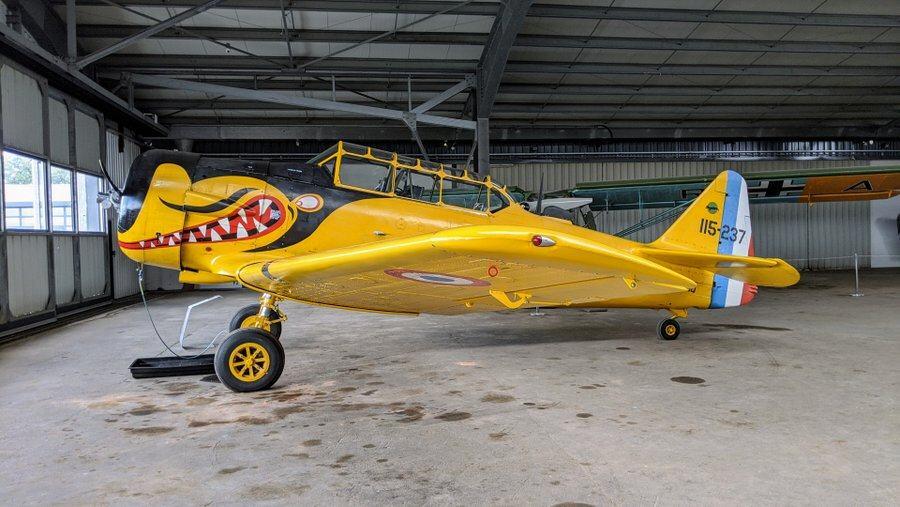
The next two hangars, Morane-Saulnier & Sports and Leisure, have around 15 aircraft in them including a few that were out on the tarmac when I was there. On this visit I didn’t spend much time in these two hangars because my time was restricted (I needed to drive to Compiegne on the other side of Paris) and I wanted to move on to the WWII hangar and out onto the tarmac. But there were a couple of highlights…
Hangar – The Morane-Saulnier collection
The Morane-Saulnier H was a successful pre-war (1913) monoplane that, with Roland Garros in the cockpit, was the first aircraft to fly across the Mediterranean (France – Tunisia 760 km in 7 hrs 53 mins) with two engine malfunctions on the way! When WWI broke out they were used in the defense of Paris, but with little success since they were armed only with the pilot’s revolver. It prompted Roland Garros to try and develop a method for firing forward-facing fixed machine guns through the propeller. He came up with an armoured propeller on a later Morane-Saulnier L model.
Garros’ engine trouble on his Med crossing didn’t seem to worry L’Amicale J.B. Salis when, starting with an original 80hp Rhône engine and factory drawings, they built this replica in 1988. Over the next quarter century it successfully notched up 66 hours in the air.
Hangar – Sports and Leisure Aviation
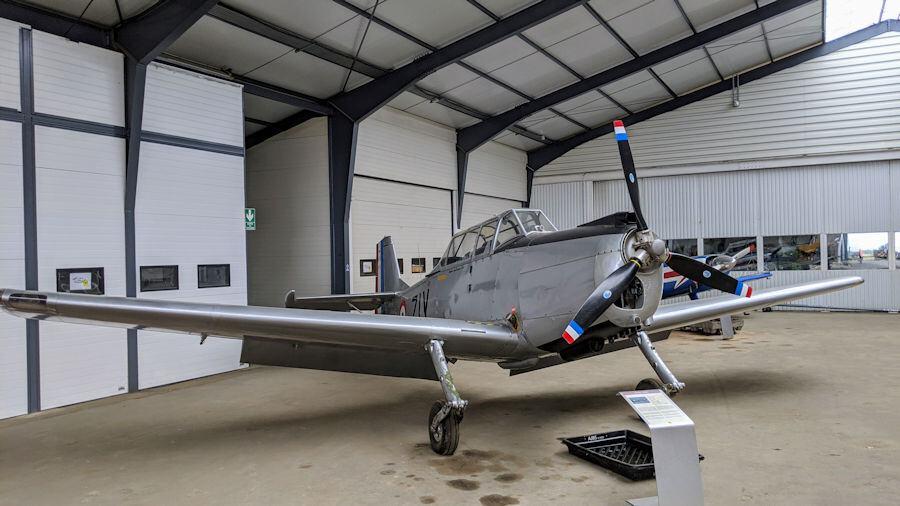
In among the stylish vintage light aircraft in this hangar, for me, the Nord 3202 trainer stood out. Built in the 1950s to be a trainer for the French Army Aviation School, it became a popular aircraft for civilian & military aerobatic pilots. This one was built in 1957 and came to L’Amicale J.B. Salis in the seventies. It was fully restored during the 90s.
Hangar – WWII memorial
There’s some cool stuff in here!
Starting with the Mitsubishi Zero A6M … except it’s not a Zero. It’s actually an American T6 Texan trainer converted to look like a Zero for the movies. I was suspicious because there are simply not many examples of the real thing around the world (only two airworthy and both in the USA), but only an expert could tell at first glance – the wing on a Zero is straight and they have slightly more rounded tail fins.
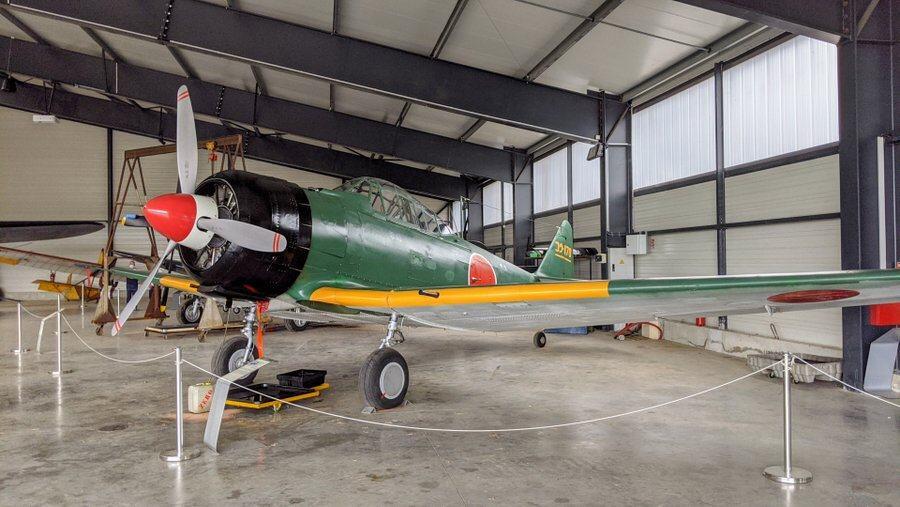
Salis Aviation used four T6 airframes to re-create a squadron of static Zeros for the movie Empire of the Sun (1987). Later in 2006 they started work to restore one of them to flight. This one first flew in 2008.
Mitsubishi Zero pilots called the plane sitting next to it “whispering death”. Not surprising. By the time the Chance-Vought Corsair F4U-5N got into the Pacific War, the Zero was getting a little old. The American Corsairs, together with those of the New Zealanders & Brits (The Royal Navy had six aircraft carriers operating off Japan in 1945) completely out-performed the hapless Zeros, shooting them down at a rate of eleven to one¹.
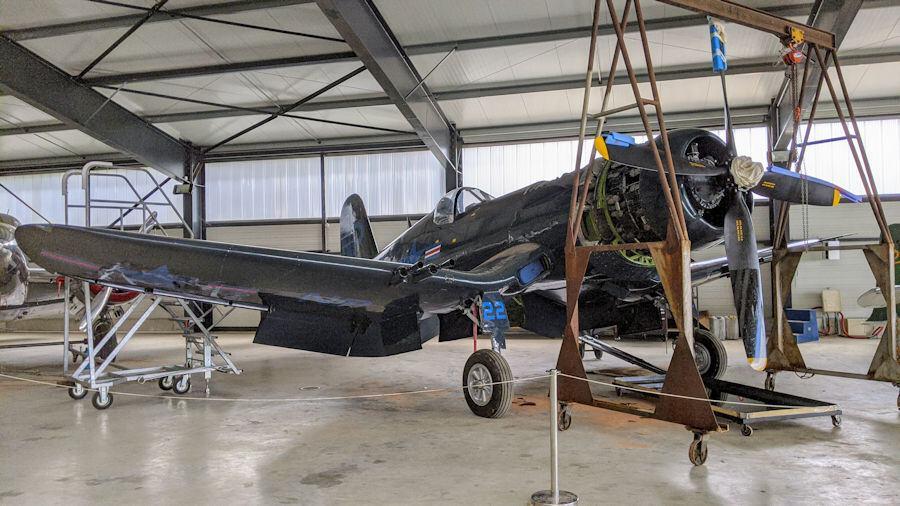
Airworthy Corsairs are not that rare, but it’s always good to see one in the air, and even on the ground they are intimidating aircraft!
Dominating this hangar is ‘The Pink Lady’, one of only two potentially airworthy Boeing B-17G bombers in Europe. I say “potentially” because, while the other, ‘Sally B’ based at Duxford in the UK, flies regularly, Pink Lady’s owner/operator Forteresse Toujours Volante took the painful decision to ground her in 2009. Which is to say, she could fly again if the money & mechanics were available. I’ll come back to that.
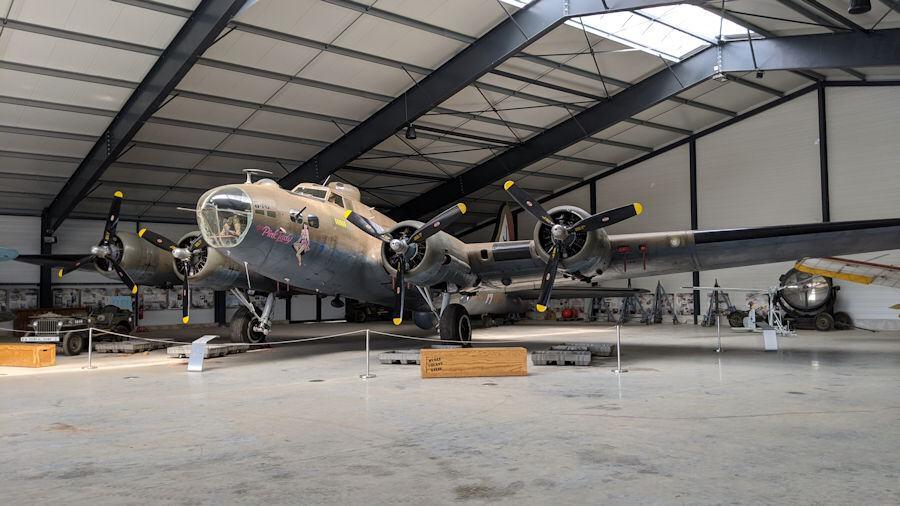
Unlike ‘Sally B’, ‘Pink Lady’ is an Eighth Air Force veteran. She is painted up in the colours of the 351st Bomb Group out of Polebrook, Northamptonshire (note the letter J on her tail) because she actually flew five missions over Germany with them in 1945, before being transferred to the 305BG for her sixth.
More recently, like Sally B, she has been in the movies******. As a result, like ‘Sally B’, she is two-faced. Both aircraft few in the movie Memphis Belle (1990). The nose art on Sally B’s starboard (co-pilot) side is ‘Memphis Belle’. The nose art on Pink Lady’s starboard side is that of the “rookie crew” ‘Mother and Country’.
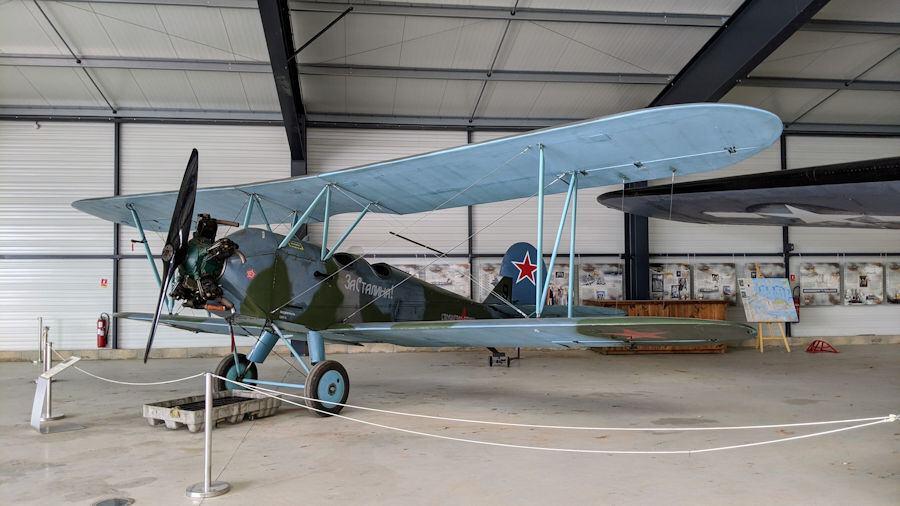
I was thinking that the Russian Polikarpov PO-2 biplane was out of it era in this hangar. However, in production from 1928 to the late 1950s, it was used as a military trainer (and for ground attack, transport, spotter, medivac, etc) & civilian trainer and general purpose light aircraft, before, during and after WW2. This was the plane used for night bombing raids on the Germans by the famous “Night Witches”; the all-female 588th Night Bomber Regiment. And it’s probable, given its popularity and long production run of over 40,000 units, that the PO-2 is the world’s most-produced biplane.
When I visited, there was another more modern trainer next to it in the hangar – the North American AT-28D Trojan.
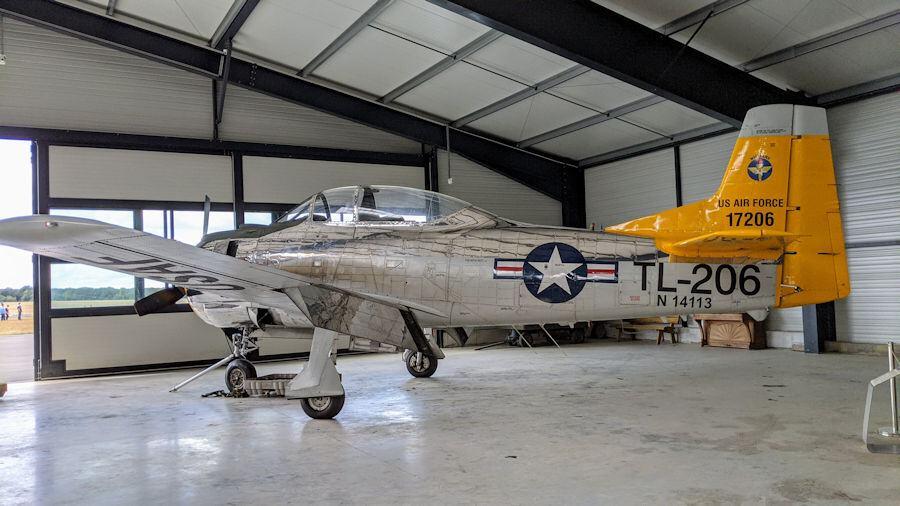
The AT-28 was designed to take over from its predecessor, the T-6 Texan (See above). It first flew in 1949 and was in production from 1950 to 1957. It was used by a number of Air Forces, particularly the USA, Vietnam, France and the Philippines, as a trainer and a ground attack, counter-insurgency aircraft. There are quite a few still flying. This shining silver & yellow example is privately owned and not on the museum’s catalogue, so she may just have been passing through.
Out on the airfield
If the weather is good and there are flying operations at the museum, then it’s possible to wander out onto the observation area by the apron to watch the comings and goings. For me, the big excitement was seeing the museum’s Douglas Skyraider AD4N out for an engine run. This was the formidable carrier & land based ground-attack plane that made its reputation for firepower and ruggedness in Vietnam during the 1960s.
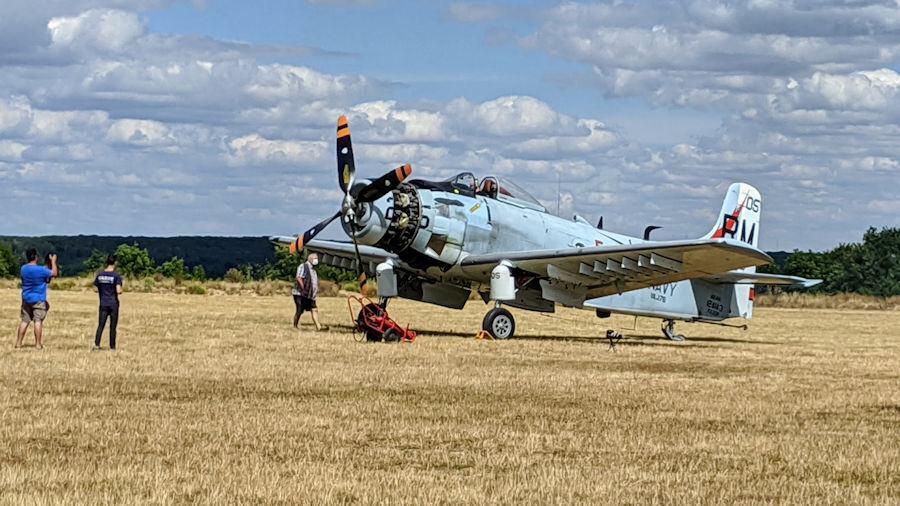
This particular Skyraider was involved in a mid-air collision at IWM Duxford’s Flying Legends Airshow almost a decade ago, and badly damaged its starboard wing, but managed to land. (Sadly, the P-51 Mustang ‘Big Beautiful Doll’ it collided with, was destroyed. The pilot parachuted to safety.) So it’s especially good to see it in good health.
“Wait! There’s another of those aircraft that don’t look quite right! What German fighter is that?”
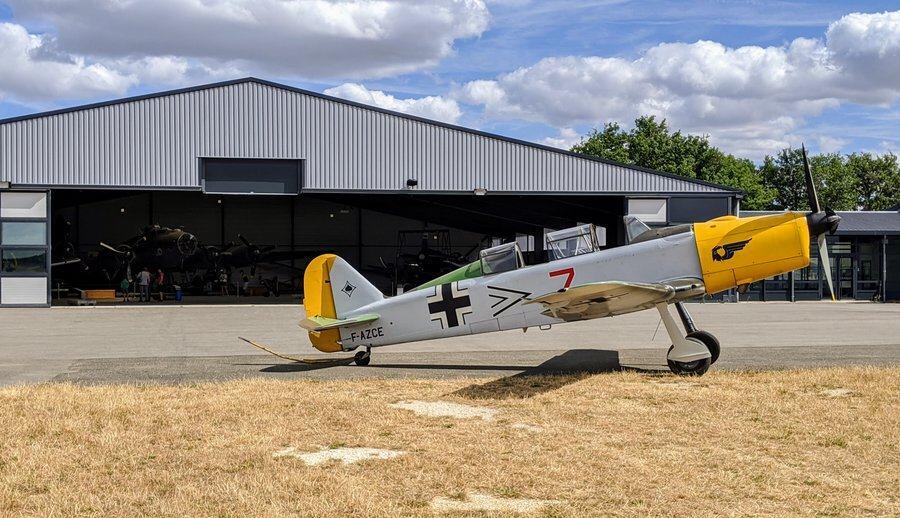
Well spotted! When I first saw the yellow nosed German fighter on the tarmac, I wondered if it was a prototype I hadn’t seen before. It reminded me of the Messerschmitt BF 108. Actually, it turns out to be a Swiss Pilatus P2 trainer. These were made as Swiss Air Force trainers just after the war and used some components from the Bf 109 such as parts of the undercarriage. Importantly, they got painted up and used for movies as stand-ins for generic German fighters. Anyone remember Indiana Jones and the Last Crusade, with Indiana (Harrison Ford) & his dad (Sean Connery) being hounded by a pair of them? There you go!
There are loads of interesting aircraft to see at the Salis Museum of Flying – leave yourself plenty of time, or reckon on returning.
| * | Their website says 70 aircraft in the collection and I don’t doubt it, but I counted just under 50 on display. |
| ** | Fuel, oil, water, hydraulic fluid, anti-freeze, etc |
| *** | Mostly for the aeronautical museum at Chalais-Meudon, which, after WW2, moved to Le Bourget and became the Musée de l’Air et de l’Espace. |
| **** | Set up in 1973 to handle film work, starting with ‘Les Faucheurs de Marguerites’. Yes, one of their first film credits, The Longest Day (Jean-Baptiste built the Horsa Glider wrecks) pre-dates the company. There’s a list of the movies at the bottom of this page. |
| ***** | Flying Legends have been operating nostalgic sightseeing flights from Duxford with a fleet of three Rapides for ages. And there’s a fourth privately owned Rapide (G-AGJG) at Duxford that was restored to flight in 2004. |
| ****** | The Pink Lady also appeared as a static prop in the movie Red Tails (2012) |
¹ The Kamikaze Hunters, Will Iredale. ISBN 978-1-4472-8471-0. (See Recommended Books)
Declaration: No need. It was a private visit and I paid for my entrance.
Factbox
COVID-19:
When I visited, basic precautions were in play; social distancing and masks in the hangars. Few people were wearing masks outside.
Currently France is in lockdown and the museum is closed.
Website:
Musée Volante Salis
Getting there:
Aérodrome de la Ferté Alais, 91590 Cerny, France
South of Paris, it’s quickest to take the A6 and then the D191 to Baulne.
Entry Price:
| 16 Nov – 14 Mar | 15 Mar – 15 Nov | |
|---|---|---|
| Adult | € 9.00 | € 12.00 |
| Child, 5-14 yrs | € 5.00 | € 6.00 |
| Disabled | € 8.00 | € 10.00 |
| Family (2 adults, 2 children) | € 23.00 | € 30.00 |
Opening Hours:
| Monday to Friday | 1400 – 1700 |
| Saturday & Sunday | 1400 – 1800 |
Events
The Ferté-Alais Air Show, now called Le Temps des Hélices (The propeller era) takes place at the airfield every Pentecost weekend (next one: 22- 23 May 2021). It is now a big deal, featuring aircraft from the air museum together with vintage aircraft from around Europe & North America, and flybys by the French Air Force, the Patrouille de France (France’s Red Arrows/Blue Angels), and civil aviation manufacturers like Airbus.

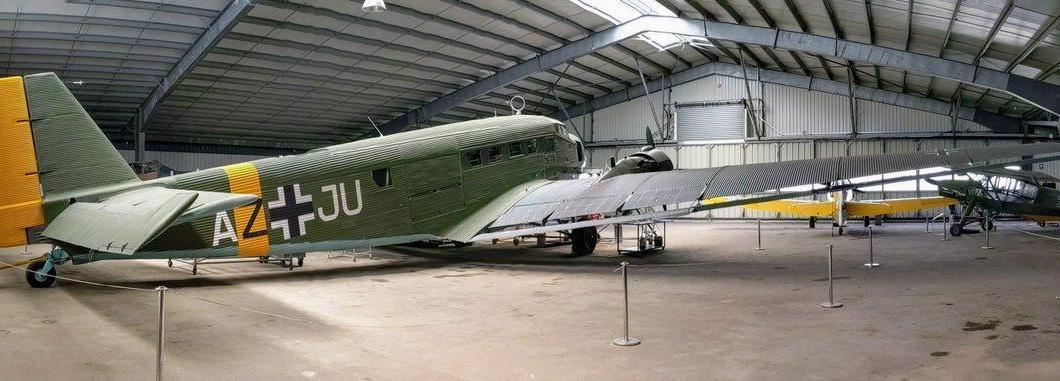
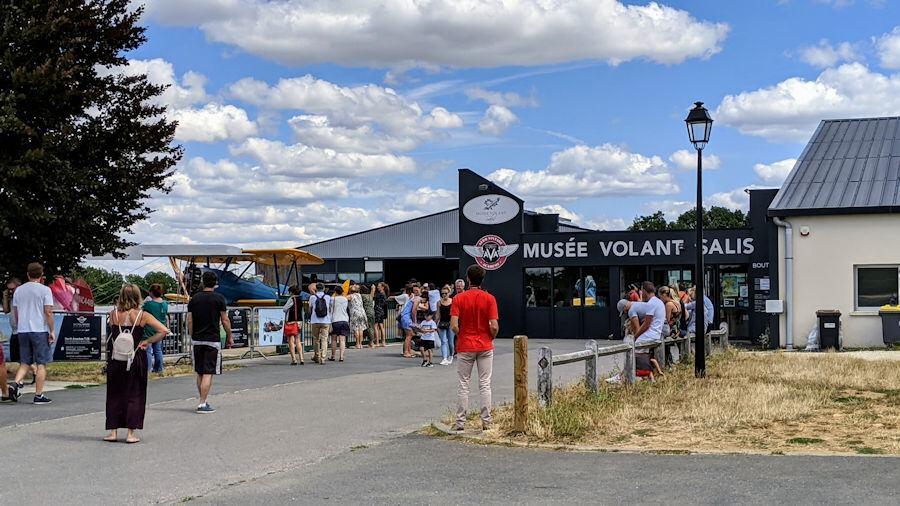
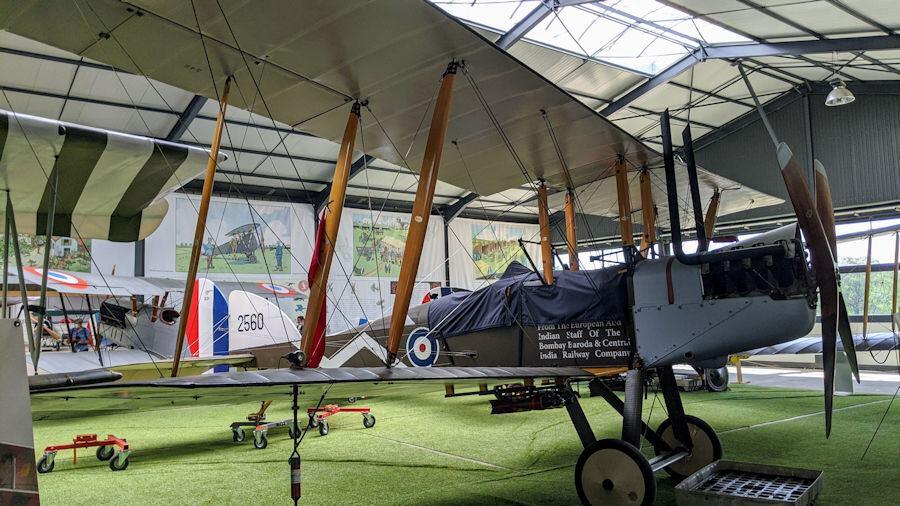
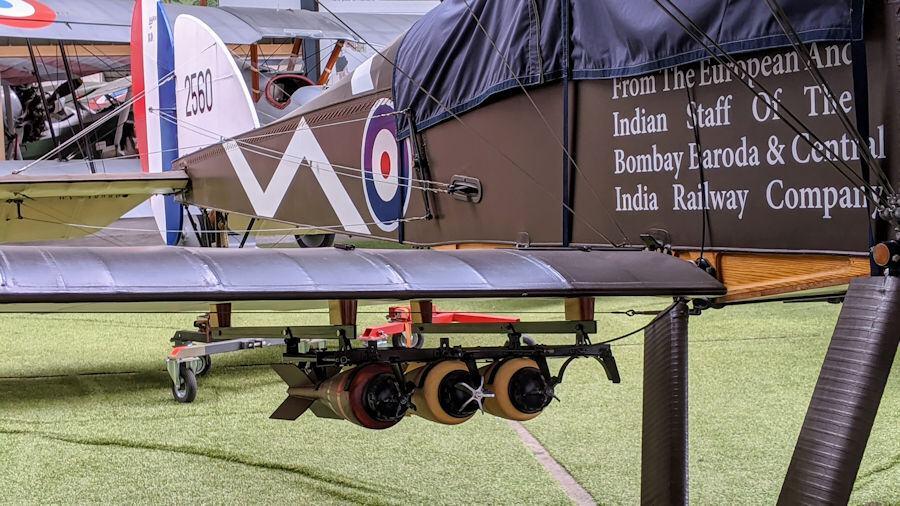
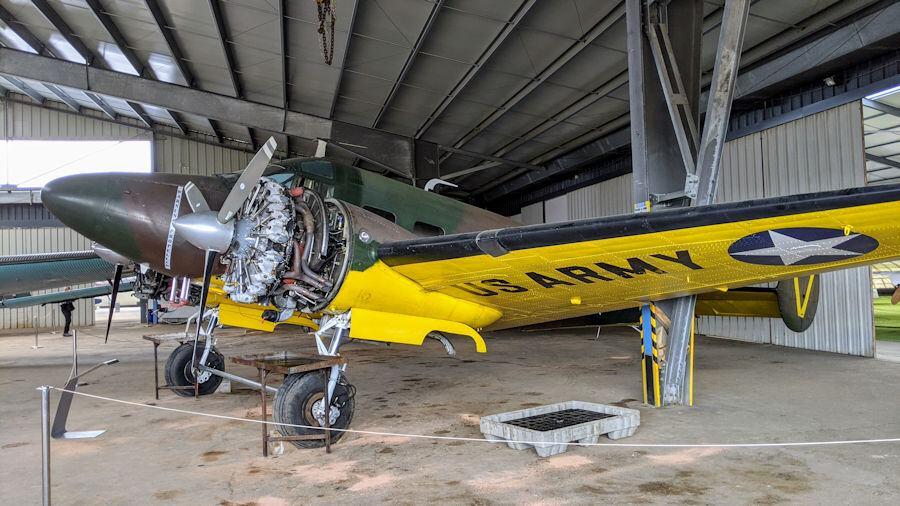
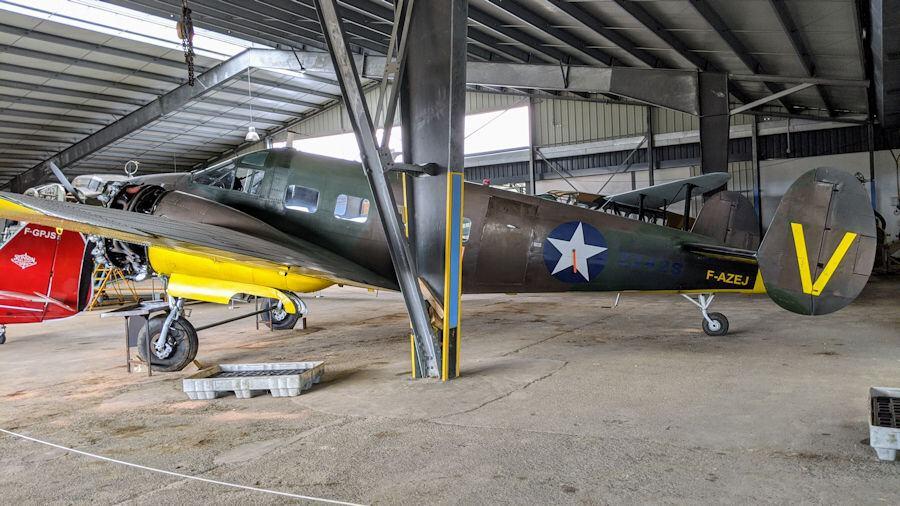
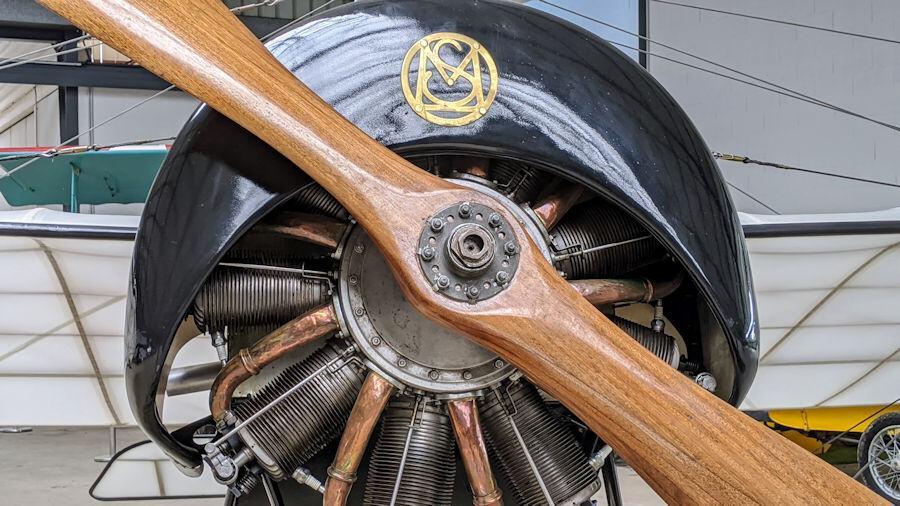
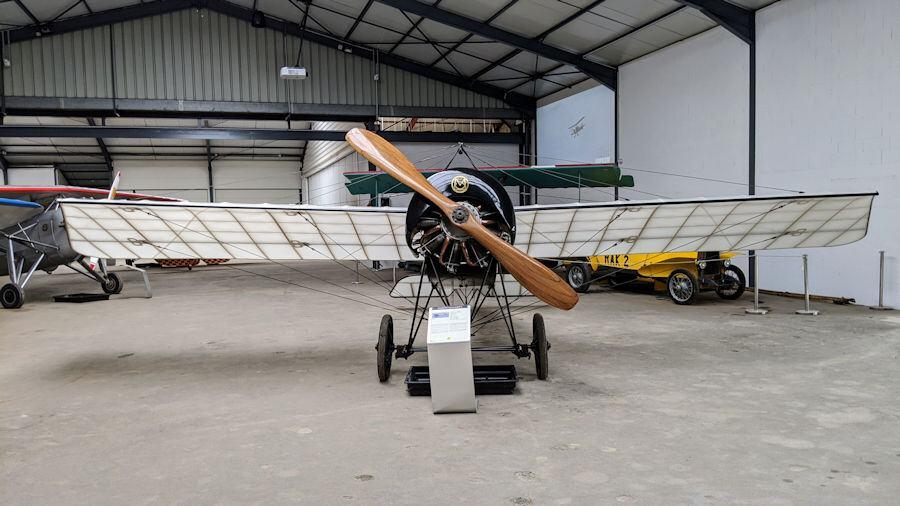
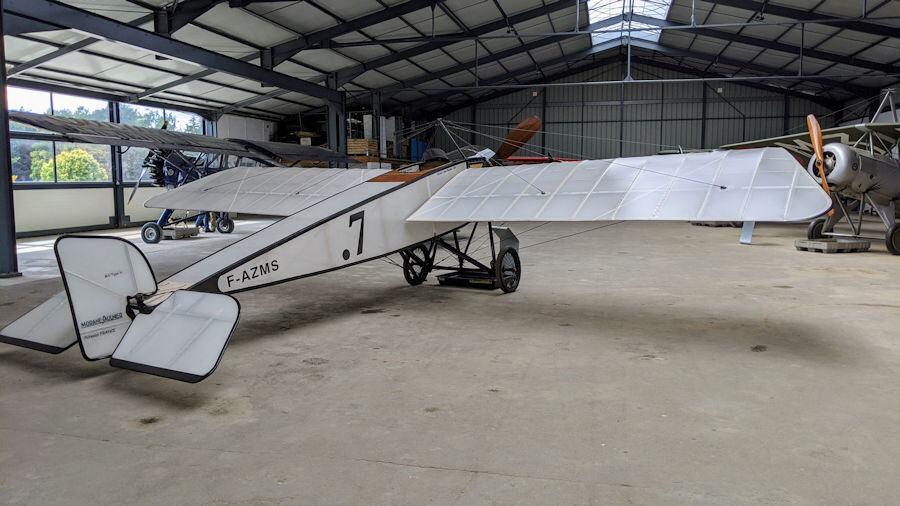

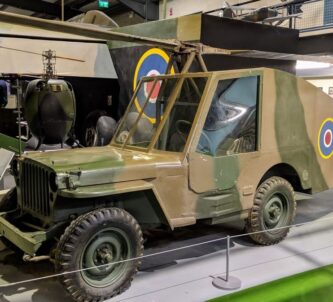

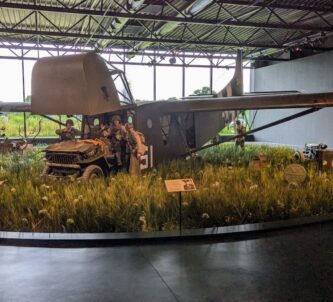
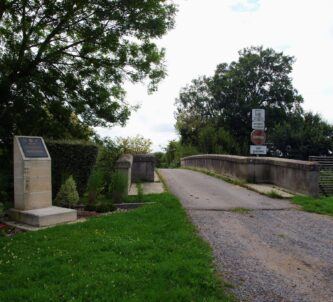

Thanks Alistair – a great review of the Museum! I saw on one online resource that the Museum also has a Spitfire XIV. Was it there when you visited? I’ll be sure to put this Museum on my list. Cheers, Jim
Hi Jim, thanks. Yes, it’s a brilliant museum; well worth going out of your way to see. No, I didn’t see a Spitfire there. Maybe added to the collection recently?
On the ‘Zero’. There is a near authentic Mitsubishi A6M3 Zero being restored to airworthiness by Legend Flyers at Paine Field in Everett, Washington. All parts original or newly made, but with a Pratt & Whitney R-1830-92 engine (they had hoped to install a fully-rebuilt Nakajima Sakae 21 engine, but that plan fell through).
Are you sure that B-17 is a G model? No chin turret and the entire nose section forward of the cockpit screams like an earlier F or E model…there was no sextant bubble on a G.
No, not completely! 🙂 I took my cue from the museum’s own signage, and Wikipedia which says “Built at Vega Burbank as B-17G. Modified to PFF ship. Flown to RAF Polebrook 1 March 1944 and assigned to 511th Bomb Squadron. Flew six missions. Sold in 1954 to Institut géographique national and used until 1985. Purchased by association Forteresse toujours volante in 1988. Wears livery of 44-8846 “Pink Lady”. Used in 1989 filming of Memphis Belle.”